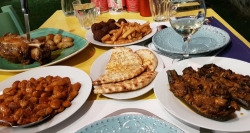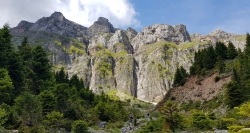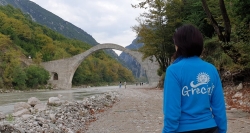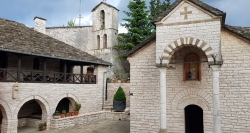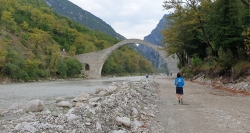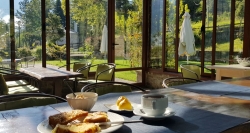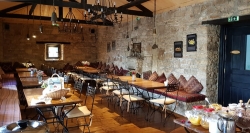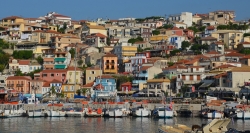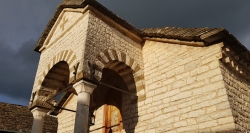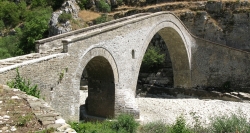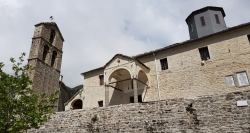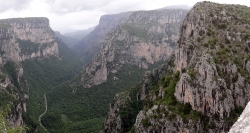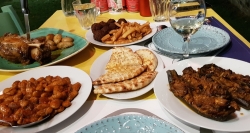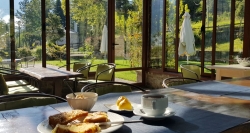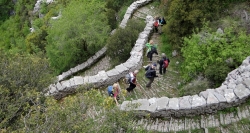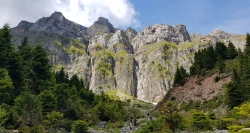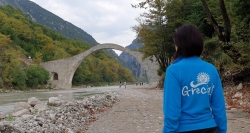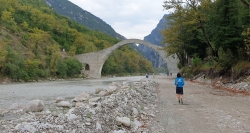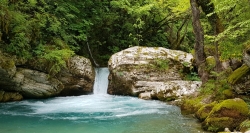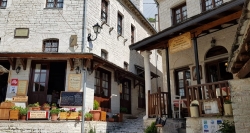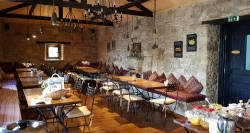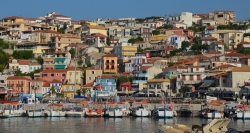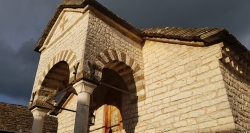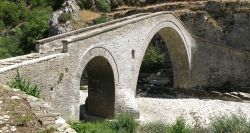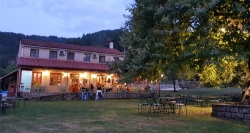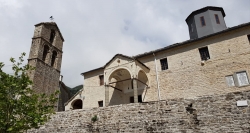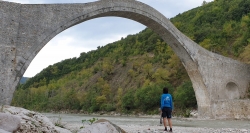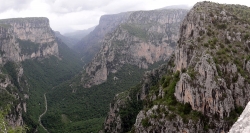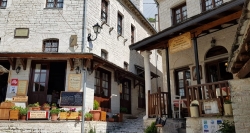Le nostre destinazioni più richieste
I nostri tour:
Common description
The Greece you don't expect
Epirus is considered internationally as an ideal place for all types of alternative tourism. Its pristine Pindus mountain mass with its large virgin forests, mountain lakes (drakolimnes - dragon lakes) and wild slopes offer a plethora of activities (mountaineering, climbing, skiing, hiking, mountain biking, in a setting of singular beauty, as well as the rivers of Epirus which offer other activities such as kayaking, rafting, canoeing.
The Epirus region is located in northwestern Greece, between the Pindus mountain range and the Ionian Sea. Mount Pindos with its virgin forest, its numerous slopes and its open "dragon lakes" (the mythical alpine lakes) offer you a myriad of activities such as mountaineering, climbing, skiing, hiking, mountain biking in a setting of singular beauty.
The rivers of Epirus will offer other activities such as kayaking, rafting, canoeing, etc. The Acheron River is considered one of the most beautiful and challenging rivers for kayaking, while Voidomatis passes through the impressive Vikos Gorge. All of the above coexists in harmony with the archaeological sites, castles, monasteries, churches and traditional villages.
Epirus is located in the northwestern part of Greece, between the Pindus mountain range and the Ionian Sea and combines impressive mountains and lovely seaside scenery. The entire area is crossed by mountains and rivers crossed by wonderful arched bridges. Fertile plains and valleys interrupt the mountain ranges from north to south.
The climate on the coast is moderate, while inland it is harsh, with harsh winters, frequent frosts and abundant rains and thunderstorms. Villages and cities have always been connected via a series of paths carved into the numerous mountains.
Ioannina, the mystical capital
Ioannina is a beautiful town in northwestern Greece. Dominated over the centuries by different peoples, it is the result of a harmonious and unique mix of traditions and cultures. Lapped by the quiet and calm waters of Lake Pamvotis, Ioannina is a destination far from the most popular routes, and for this reason it still retains its charm intact.
Today an economic and cultural center, Ioannina was an important city of the Byzantine Empire, of the Despotate of Epirus and during the Turkish occupation. From the old city to the castle, from the bazaars to the monasteries: everything here speaks of history.
Zagori
Pay a visit to Zagorochoria, 46 unique villages located in the mountains. While staying in one of these villages you can walk in nearby Vikos Canyon, the second deepest in the world, with an ecosystem of 1,700 plant species and 182 animal species. Cross the historic stone bridges of Epirus, where local legends and traditions leave their mark on these architectural masterpieces.
Explore Dodoni, the famous oracle of ancient times and don't forget a visit to the famous Dodoni Theatre, the largest of antiquity and finally taste some of the most delicious varieties of feta, the quintessential cheese of Greece
The name "Zagori" is Slavic and means "beyond the mountains". During Ottoman rule, the area reached its economic and intellectual peak. However, Zagori declined after the death of Ali Pasha (1822) when he lost the benefits he enjoyed. The wars of the 20th century also had devastating effects. Zagori is divided into Western, Central and Eastern Zagori.
The Epirus Riviera
Summer holidays in Greece are synonymous with the islands scattered across the Ionian and Aegean Seas. However, the coasts of mainland Greece hide fascinating places that promise to offer unforgettable moments.
In the northwestern coast of Epirus with a view of the blue-green waters of the Ionian archipelago, charming Parga and exotic Sivota make an irresistible couple with an island breeze and a cosmopolitan aura, sure to steal your heart .
• Parga
Parga is a renowned seaside city in the Prefecture of Preveza as well as a popular holiday destination. It is built amphitheatrically, nestled in a picturesque bay, where the small wooded island of Panagia sits in the shadow of the town's Venetian castle.
Take a walk to the historic centre, where you will enjoy distinct architecture, stroll through its stone cobbled streets with beautiful arches, discover flower-filled neighborhoods where quaint little houses and colorful buildings and end up drinking in the mesmerizing sunset view of le emerald waters of the Ionian Sea from the Venetian walls.
As night falls, take a romantic walk along the seafront lined with tourist shops, nice trendy restaurants and small bars where you can drink or eat with a view of the illuminated castle and the islet of Panagia.
• Sivota
Sivota is considered one of the most exotic destinations in Greece: green islets, long sheltered beaches with crystal clear waters and secret coves
History of Epirus in brief
The first inhabitants of Epirus were the Pelasgians. Homer mentioned the tribes of Epirus such as the Thesprotians and the Selians. Subsequently, their kings claimed to be descendants of Achilles. Epirus appears in Greek history in the 7th century BC. In Roman years, it was separated into Old and New Epirus.
In the following centuries, Epirus was invaded by Goths, Huns and Bulgarian tribes. Subsequently, King Voulgaroktonos removed the Bulgarians. The Despotate or Principality of Epirus appeared with the arrival of the Franks. Its capital, Arta, became the center of national resistance and Byzantine spiritual culture. In 1431 the Turks occupied the city of Ioannina and Epirus.
During Ottoman rule, mountain villages enjoyed many advantages and autonomous administration, while at the same time its inhabitants developed trade and traveled extensively in the Balkans and Central Europe.
The wealthy immigrants of Epirus brought European wealth and culture to their homeland. One of the most flourishing areas of the time was Zagorohoria, or the Zagori villages, where notable monuments of notable historical and architectural value were built, such as stone arch bridges and large mansions.
Bricklayers, foremen, sculptors, hagiographers and carpenters from Epirus traveled extensively to guilds to work in the Balkans.
Much of the culture of 18th- and 19th-century Epirus that survives to this day reveals the prosperity of folk art and architecture in this part of Greece.
In 1881, Epirus was liberated up to Arta, while the rest of the region was incorporated into Greece in 1913.
More information, useful advice and curiosities in the travel documents that will be sent before departure.
Epirus is considered internationally as an ideal place for all types of alternative tourism. Its pristine Pindus mountain mass with its large virgin forests, mountain lakes (drakolimnes - dragon lakes) and wild slopes offer a plethora of activities (mountaineering, climbing, skiing, hiking, mountain biking, in a setting of singular beauty, as well as the rivers of Epirus which offer other activities such as kayaking, rafting, canoeing.
The Epirus region is located in northwestern Greece, between the Pindus mountain range and the Ionian Sea. Mount Pindos with its virgin forest, its numerous slopes and its open "dragon lakes" (the mythical alpine lakes) offer you a myriad of activities such as mountaineering, climbing, skiing, hiking, mountain biking in a setting of singular beauty.
The rivers of Epirus will offer other activities such as kayaking, rafting, canoeing, etc. The Acheron River is considered one of the most beautiful and challenging rivers for kayaking, while Voidomatis passes through the impressive Vikos Gorge. All of the above coexists in harmony with the archaeological sites, castles, monasteries, churches and traditional villages.
Epirus is located in the northwestern part of Greece, between the Pindus mountain range and the Ionian Sea and combines impressive mountains and lovely seaside scenery. The entire area is crossed by mountains and rivers crossed by wonderful arched bridges. Fertile plains and valleys interrupt the mountain ranges from north to south.
The climate on the coast is moderate, while inland it is harsh, with harsh winters, frequent frosts and abundant rains and thunderstorms. Villages and cities have always been connected via a series of paths carved into the numerous mountains.
Ioannina, the mystical capital
Ioannina is a beautiful town in northwestern Greece. Dominated over the centuries by different peoples, it is the result of a harmonious and unique mix of traditions and cultures. Lapped by the quiet and calm waters of Lake Pamvotis, Ioannina is a destination far from the most popular routes, and for this reason it still retains its charm intact.
Today an economic and cultural center, Ioannina was an important city of the Byzantine Empire, of the Despotate of Epirus and during the Turkish occupation. From the old city to the castle, from the bazaars to the monasteries: everything here speaks of history.
Zagori
Pay a visit to Zagorochoria, 46 unique villages located in the mountains. While staying in one of these villages you can walk in nearby Vikos Canyon, the second deepest in the world, with an ecosystem of 1,700 plant species and 182 animal species. Cross the historic stone bridges of Epirus, where local legends and traditions leave their mark on these architectural masterpieces.
Explore Dodoni, the famous oracle of ancient times and don't forget a visit to the famous Dodoni Theatre, the largest of antiquity and finally taste some of the most delicious varieties of feta, the quintessential cheese of Greece
The name "Zagori" is Slavic and means "beyond the mountains". During Ottoman rule, the area reached its economic and intellectual peak. However, Zagori declined after the death of Ali Pasha (1822) when he lost the benefits he enjoyed. The wars of the 20th century also had devastating effects. Zagori is divided into Western, Central and Eastern Zagori.
The Epirus Riviera
Summer holidays in Greece are synonymous with the islands scattered across the Ionian and Aegean Seas. However, the coasts of mainland Greece hide fascinating places that promise to offer unforgettable moments.
In the northwestern coast of Epirus with a view of the blue-green waters of the Ionian archipelago, charming Parga and exotic Sivota make an irresistible couple with an island breeze and a cosmopolitan aura, sure to steal your heart .
• Parga
Parga is a renowned seaside city in the Prefecture of Preveza as well as a popular holiday destination. It is built amphitheatrically, nestled in a picturesque bay, where the small wooded island of Panagia sits in the shadow of the town's Venetian castle.
Take a walk to the historic centre, where you will enjoy distinct architecture, stroll through its stone cobbled streets with beautiful arches, discover flower-filled neighborhoods where quaint little houses and colorful buildings and end up drinking in the mesmerizing sunset view of le emerald waters of the Ionian Sea from the Venetian walls.
As night falls, take a romantic walk along the seafront lined with tourist shops, nice trendy restaurants and small bars where you can drink or eat with a view of the illuminated castle and the islet of Panagia.
• Sivota
Sivota is considered one of the most exotic destinations in Greece: green islets, long sheltered beaches with crystal clear waters and secret coves
History of Epirus in brief
The first inhabitants of Epirus were the Pelasgians. Homer mentioned the tribes of Epirus such as the Thesprotians and the Selians. Subsequently, their kings claimed to be descendants of Achilles. Epirus appears in Greek history in the 7th century BC. In Roman years, it was separated into Old and New Epirus.
In the following centuries, Epirus was invaded by Goths, Huns and Bulgarian tribes. Subsequently, King Voulgaroktonos removed the Bulgarians. The Despotate or Principality of Epirus appeared with the arrival of the Franks. Its capital, Arta, became the center of national resistance and Byzantine spiritual culture. In 1431 the Turks occupied the city of Ioannina and Epirus.
During Ottoman rule, mountain villages enjoyed many advantages and autonomous administration, while at the same time its inhabitants developed trade and traveled extensively in the Balkans and Central Europe.
The wealthy immigrants of Epirus brought European wealth and culture to their homeland. One of the most flourishing areas of the time was Zagorohoria, or the Zagori villages, where notable monuments of notable historical and architectural value were built, such as stone arch bridges and large mansions.
Bricklayers, foremen, sculptors, hagiographers and carpenters from Epirus traveled extensively to guilds to work in the Balkans.
Much of the culture of 18th- and 19th-century Epirus that survives to this day reveals the prosperity of folk art and architecture in this part of Greece.
In 1881, Epirus was liberated up to Arta, while the rest of the region was incorporated into Greece in 1913.
More information, useful advice and curiosities in the travel documents that will be sent before departure.

